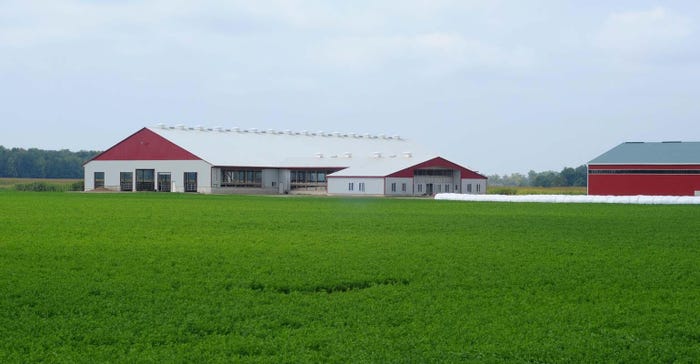Weeds are a high-protein forage. And your cows can learn to love them. That and more awaits you in this week’s Trending Headlines.

Yes, your cows can learn to eat weeds, even in very large pastures
One of the sticking points preventing some ranchers from training their livestock to eat weeds is that by the time the weeds are up, they also need to move their cattle to pasture to take advantage of rapid grass growth. How do you work with cattle that may be spread over really large pastures?
The basic training process involves feeding cows “treats” in tubs morning and afternoon over four days. These treats are an assortment of different feeds in 50-pound bags. I choose eight different high protein feeds, focusing on things the cows have never seen before and that are high in protein, and are different sizes, shapes, textures, smells and tastes, reports onpasture.com.
By the second day, the trainees expect that I’m bringing them a great snack whenever they see me with tubs, and they come running. On the fifth day, when I switch the feeds for weeds, they try them because everything else I put in the tub looked strange but turned out to be tasty.
Click here to read more and watch a short video.
Baseball fans love their hot dogs; predicted to eat more than 19 million

What is more American than baseball? And what is the iconic food for baseball fans? Hot dogs, of course. But in today’s MLB parks, the hot dog has become more than just a hot dog.
With Major League Baseball teams starting the season last week, the action will not only be on the field of play. Concession stands at major league ballparks will also be getting a workout as the National Hot Dog and Sausage Council estimates that baseball fans will consume more than 19 million hot dogs and 4.6 million sausages during the 2018 MLB season. The combined hot dog and sausage total could stretch the entire continental U.S. from Safeco Field in Seattle, Wash., to SunTrust Park in Atlanta, Ga. The hot dog total alone would reach as high as 5,332 One World Trade Centers, the tallest building in the Western Hemisphere and sixth tallest in the world, reports Southwest Farm Press.
Click here for a full scoresheet on this year’s hot dog champions.
Mixed macroeconomic signals shaking cattle market amid higher beef production

At the moment, Derrell Peel, livestock marketing economist at Oklahoma State University, describes the current U.S. economy as having "one foot on the accelerator and another foot on the brakes, making it extremely difficult to figure out what happens next or, perhaps more importantly, what happens after that."
So, should cattle producers be running for cover? Probably not yet, Peel advised, but says it is not a bad idea to have a plan in place if the worst should happen, according to the Oklahoma Farm Report.
"I recommend figuring out where cover is and how you can get there at a moment's notice," he says. "Cattle producers need to closely monitor the broad range of macroeconomic and global conditions and be prepared to abruptly switch to a strongly defensive business strategy. Markets are increasingly volatile and it will be important to maintain as much short-term flexibility as possible to deal with rapidly changing conditions. The uncertainty and volatility likely has not peaked yet but one hopes that it will be followed relatively soon by more clarity and stability. However, there is certainly no guarantee of that and producers must be prepared to hunker down and weather the storm."
Click here to read more of Peel's advice.
Farmers seek cure for runaway health care costs

Skyrocketing premiums and high deductibles have taken a big bite out of farm family budgets, but a new report by Farm Futures explains how some of those families are fighting back.
While there is currently no blanket solution for hemorrhaging health care costs, some farm families are finding ways to improve their situation, reports Farm Futures. For Minnesota farmer Matt Krueger, the answer is in a new cooperative that helps farm families lower deductibles and obtain broader coverage, such as vision and dental. Meanwhile Washington farmer Brad Haberman captures $400 per month in premium savings with an association plan orchestrated by the Washington Farm Bureau. The Department of Labor is working to tweak the current health care mandate to allow for greater association participation.
Keep replacement heifers' nutritional management front of mind as spring breeding season nears

According to research, heifers near the time of reaching puberty undergo a severe reduction in dietary intake of protein and especially energy, which can cause breeding success to be potentially disappointing, says Glenn Selk, emeritus animal scientist at Oklahoma State University.
"The effects of acutely restricting nutrition on ovulation and metabolic hormones were evaluated in Angus x Hereford heifers," he says. "All of the heifers were housed in individual pens in a barn and fed a diet supplying 120% of their maintenance requirements for protein and energy for 10 days to allow time to adjust to the environment and diet. All the heifers were cycling at the conclusion of this adjustment period. Then the heifers were split into two groups. Half of the heifers were then fed a diet supplying either 40% of their maintenance requirements. The other half of the heifers were continued on the original diet that supplied 120% of the maintenance requirements.
Restricting nutrient intake for 14 days prevented ovulation in a large percentage of these heifers without altering visible body condition. Selk concludes that heifers should be managed to avoid short-term nutrient restriction to maintain normal estrous cycles, according to the Oklahoma Farm Report.
CoBank report finds 2018 brings risks, opportunities for ag

There are abundant opportunities for U.S. agriculture this year amid drought in South America and growing export prospects; however, those opportunities are at risk, according to the latest Rural Economic Review from CoBank’s Knowledge Exchange Division.
“Optimism over global economic growth in 2018 remains high, but it is clear that downside risks to growth far outweigh the likelihood of upside surprises,” said Dan Kowalski, vice president of CoBank’s Knowledge Exchange Division. “We are looking at 4% global growth, the highest since 2011 - developed countries such as the U.S. are providing the global stimulus needed for that growth - but trade concerns now put that at risk.”
About the Author(s)
You May Also Like



